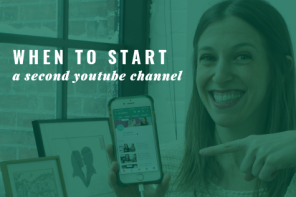Are you using video yet as a part of your social media marketing strategy?
While video can be time-consuming to create, it’s well worth the effort.
If you haven’t started to play around with, and strategize, how you can use video as a part of your social strategy, it’s time to start.
Through video, businesses and brands are creating deeper connections to their customers than ever before.
Whether you’re creating videos on YouTube, Twitter, Facebook and/or Instagram, there are some best practices that apply to every platform.
I mean, it’s thanks to video that Facebook is innovating at unprecedented rates; it seems like every day there is a new feature or function that increases the power and prioritization that video is getting in the newsfeed.
So, how can you get started? What steps should you follow? How do you proceed with limited resources?
It all comes down to testing. You’re going to need to try new and different things before you see what resonates with your audience.
There are some concepts that, regardless of your industry and/or budget, you can utilize in order to start creating valuable videos for your online audience.
Here are 11 ideas for how you can start to use video as a business:
- Behind the scenes: Pull back the curtain, and take your audience with you to give them insight into your production progress, products, team and culture. By showing behind-the-scenes snapshots and snippets, you help your fans feel more connected to your business. These videos generate excitement about what you’re working on and/or opportunities to get involved. This type of video content makes your fans feel like they are an insider, getting exclusive access to things. Transparency online builds trust.
- Be human: Video is powerful and popular because it’s human. Videos draw on people’s emotions, and emotions are memorable. When you can tell a story through video that elicits emotions, you will stay top-of-mind to your fans. The more you can tap into people’s emotions through voice inflection and facial expressions, the more they’ll remember the video.
- Educate: Use video to share your expertise and/or thought leadership. Teach people about tricks or tactics they can try; this will help you become more trustworthy and credible online. Plus, if your video is super valuable, it’ll drive repeat visitors to your pages.
- Giveaways & promotions: Video is great for sharing promotional codes, coupons and limited-time offers. When you share an exclusive deal through video, typically at the end of the video, only those who stayed on to watch the full video are rewarded; that’s a win-win.
- Autoplay awareness: When people scroll through their news feed, videos automatically start playing as they pass over the screen. To encourage people to watch your video, you want to make your video active within the first few seconds. Feature movement within the first few frames to grab attention. Making your hook early, by telling people why they should watch your video and/or what you’re going to deliver early on, will help drive viewership.
- Add subtitles: To cater to the hearing impaired, and to operate with awareness of the autoplay feature, you want to add captions and subtitles to your videos. This is a great way to preserve the value of the video, as people will be able to get the gist of what your video is about by reading the captions. When you don’t require viewers to turn on the sound to get the value, you make it easy for them to “sneak in” your videos during their work day.
- Drive action: Using calls to action drives your audience to do something, whether it’s downloading your guide or filling out a form on your website. Video is more personal than text, so asking people to take action through video is more effective in driving desired behavior. It’s best to place your calls to action at the end of the video, so that users are incentivized to take the action immediately after viewing.
- Q&A: Do you get a lot of frequently asked questions from your online audience? Do a live Q&A where you answer popular questions that people have asked and open yourself up to answer questions in real-time. Live Q&A’s are extremely engaging and help you position yourself as an expert in your industry because you can’t “pre-plan” answers to questions that come up on a live broadcast.
- Strong headlines & thumbnails: Be sure to pair your video with strong headlines, as the headline is going to be what gets someone to click. Your headline should be accurate; it should give people an idea of what the video will be about. Using keywords in the headline will help with being found on search. Just like your headline, your thumbnail image will be what drives clicks for the video. Make it bright and catchy, without being cluttered.
- Brand your videos: Including your logo on your video will help you build brand awareness, especially if your fans end up sharing your video on social. Don’t make your logo too be though, make it subtle.
- Keep it simple: Stick to ONE call to action in your videos, as well as one topic. You don’t want to clutter up the content by sharing too many stories or messages. Share your one desired call to action at the end of the video, and focus on new messaging for the next video.
Regardless of whether you’ve created one video or one hundred, there is always room for growth and improvement.
The best social media marketers are using video as a way to educate, inspire and entertain their online audience.
Think outside of the box on how you can bring your audience behind-the-scenes, deliver value and special offers, and answer their questions.
There’s no doubt that the power, features, and benefits that video has to marketers will only grow in coming years.
Are you taking the steps today to start planning for it?
Watch my YouTube video to get 5 simple starter ideas for using video as a business!





